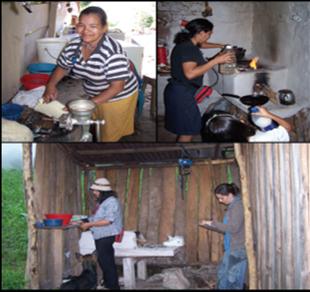Air Pollution and Respiratory Health among Honduran Women (2 MB pdf)poster
M.L. Clark,1 J.L. Peel,1 S. Conway,2 J.B. Burch,3 S.J. Reynolds 1 2006
1Colorado State University, Fort Collins, CO; 2Trees Water & People, Fort Collins, CO; 3University of South Carolina, Columbia, SC
ABSTRACT
Improved cookstoves have the potential to substantially reduce indoor air pollution. Studies examining the relationship between stove use and pulmonary function have been inconsistent, relying mostly on proxies of exposure, such as type of stove or fuel. We conducted a crosssectional survey among 79 non-smoking Honduran women, 38 with traditional stoves and 41 with improved stoves with chimneys. For 59 of these women, particulate matter (PM2.5) was assessed via 8-hour indoor, outdoor, and personal monitoring. Carbon monoxide (CO) was assessed via 8-hour indoor monitoring and 20-minute outdoor monitoring. Kitchen parameters, carbon dioxide, and relative humidity were determined to estimate ventilation rates that may affect CO and PM2.5.
Pulmonary function testing, including forced expiratory volume in one second (FEV1) and peak expiratory flow (PEF), respiratory symptoms, and demographic characteristics were assessed. Stove quality was scored on a 4-level subjective scale representing potential for indoor emissions,ranging from poorly functioning traditional stoves to well-functioning improved stoves. Personal PM2.5 means corresponding to this scale were 236, 119, 82, and 66 ?g/m3, respectively.
Corresponding kitchen PM2.5 means were 1258, 532, 294, and 218 ?g/m3, respectively; kitchen CO means were 9.18, 3.29, 1.30, and 0.16 ppm, respectively. Usual presence of cough, wheeze, and headache was reported more frequently among traditional stove users as compared to improved stove users (p<0.01). Data collected will allow for examination of the association between air quality measurements and respiratory function, while adjusting for important covariates.Supreme

